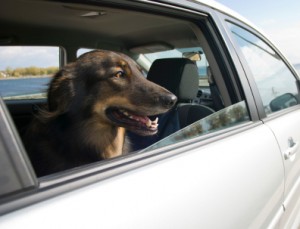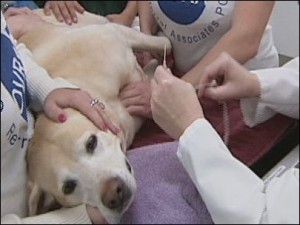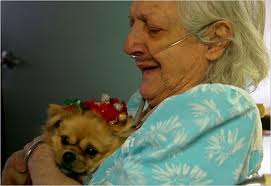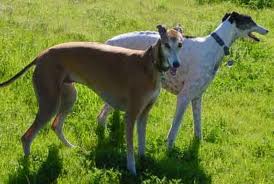Archive for October, 2010
Rescuing a dog in distress
 Veterinary Technician, Virginia Rudde of the Minnesota School of business says that when it comes to protecting a pet in an emergency, you must plan ahead. She says that you have to make sure that the whole family is in on the plan and that all members know what their part is. This will make things go much smoother in an emergency. The means keeping a collar and dog leash, food and water and your pets medical records on hand in case you need to evacuate. Rudde also recommends microchips or another type of permanent identification that won’t be affected if your pet is lost or is injured. During a disaster, emergency personnel such as a policeman or fireman may ask your neighbors if there is a pet inside your home. It’s a good idea to give emergency personnel a list of contacts who will be able to answer questions about your pet in your absence.
Veterinary Technician, Virginia Rudde of the Minnesota School of business says that when it comes to protecting a pet in an emergency, you must plan ahead. She says that you have to make sure that the whole family is in on the plan and that all members know what their part is. This will make things go much smoother in an emergency. The means keeping a collar and dog leash, food and water and your pets medical records on hand in case you need to evacuate. Rudde also recommends microchips or another type of permanent identification that won’t be affected if your pet is lost or is injured. During a disaster, emergency personnel such as a policeman or fireman may ask your neighbors if there is a pet inside your home. It’s a good idea to give emergency personnel a list of contacts who will be able to answer questions about your pet in your absence.
Protecting your dog in a car accident
 On Wednesday, a friend of a friend of mine was driving on the Long Island Expressway with his two dogs. He was side swiped by a truck. The front windshield was shattered and the car was totaled. Miraculously, neither he or his smaller dog was injured seriously. The smaller dog remained in the car. His larger dog, got so terrified, that it leaped through the shattered windshield and began running down the Long Island Expressway. If anyone knows the L.I.E. you know that it is always loaded with tons of traffic and lots of trucks! The man got out of the car, took his smaller dog and began running down the highway to look for his larger dog. What a horror!! The good news is that he did finally catch up with his dog who was still very scared and all three quickly got out of this awful situation. When he got back to his car, the cops were there wondering why he left the vehicle. Who cares!! As long as he and the dogs were safe.
On Wednesday, a friend of a friend of mine was driving on the Long Island Expressway with his two dogs. He was side swiped by a truck. The front windshield was shattered and the car was totaled. Miraculously, neither he or his smaller dog was injured seriously. The smaller dog remained in the car. His larger dog, got so terrified, that it leaped through the shattered windshield and began running down the Long Island Expressway. If anyone knows the L.I.E. you know that it is always loaded with tons of traffic and lots of trucks! The man got out of the car, took his smaller dog and began running down the highway to look for his larger dog. What a horror!! The good news is that he did finally catch up with his dog who was still very scared and all three quickly got out of this awful situation. When he got back to his car, the cops were there wondering why he left the vehicle. Who cares!! As long as he and the dogs were safe.
How could we protect our dogs and cats in the event of an accident? It’s always much safer to keep them in their cat or dog crate but lots of dogs love riding in the car with their owners. I would then recommend, getting them a dog harness that’s called a “roadie.” You can get them from ruffrider.com. They work like a seat belt and strap your dog in and restrain him. I would always recommend either the crate or the harness. Drive safely all the times, especially if you have children or pets with you!
Is your cat pregnant?
 Cats usually have very few problems giving birth. If you are breeding your cat you want to insure a smooth pregnancy and delivery. A checkup before breeding will make sure that your cat is healthy and ready to carry her litter for the nine week term. A follow up exam and ultra sound at four weeks will allow your veterinarian to determine the number of kittens. If the litter is small, this could mean larger kittens and possible delivery problems. Before your cat is ready to deliver, prepare a cat bed or a box in an out of the way place such as a closet. The spot should be quiet, warm and secure for your cat and kittens. After she gives birth, watch and make sure that the kittens bond properly.
Cats usually have very few problems giving birth. If you are breeding your cat you want to insure a smooth pregnancy and delivery. A checkup before breeding will make sure that your cat is healthy and ready to carry her litter for the nine week term. A follow up exam and ultra sound at four weeks will allow your veterinarian to determine the number of kittens. If the litter is small, this could mean larger kittens and possible delivery problems. Before your cat is ready to deliver, prepare a cat bed or a box in an out of the way place such as a closet. The spot should be quiet, warm and secure for your cat and kittens. After she gives birth, watch and make sure that the kittens bond properly.
Destructive Dogs
 If your dog is hyper when he is left alone, trouble could be brewing for you and your neighbors. Toria Voight, an Animal Behaviorist at Western University says that some dogs bark and chew things while their owners are out because most of the time, they have separation anxiety. The destructive behavior is a means to gain re access to the owner. To prevent this bothersome behavior, slowly acclimate your dog to being alone. It’s also very important that you exercise your dog regularly and provide lots of dog toys to help him get through the day. If the dog is still anxious in your absence, your should call an animal behaviorist or ask your veterinarian about prescription medication.
If your dog is hyper when he is left alone, trouble could be brewing for you and your neighbors. Toria Voight, an Animal Behaviorist at Western University says that some dogs bark and chew things while their owners are out because most of the time, they have separation anxiety. The destructive behavior is a means to gain re access to the owner. To prevent this bothersome behavior, slowly acclimate your dog to being alone. It’s also very important that you exercise your dog regularly and provide lots of dog toys to help him get through the day. If the dog is still anxious in your absence, your should call an animal behaviorist or ask your veterinarian about prescription medication.
Preventing prostate problems in dogs
 When a dog’s prostate becomes enlarged, it becomes a target for cysts and infections. You can tell whether or not your dog has a problem with his prostate. He will strain to urinate or he could have blood in his urine. If his case is severe, he could become very ill or even collapse. Prostate disease is most common in non neutered dogs. Even so, all male dogs should be examined annually for prostate disease especially if the dog is a little older. Your vet will determine whether the prostate is the appropriate size and in the right position and whether it’s irregular or smooth. If your vet finds any abnormalities, pet medication, surgery or neutering may be recommended to correct the problem.
When a dog’s prostate becomes enlarged, it becomes a target for cysts and infections. You can tell whether or not your dog has a problem with his prostate. He will strain to urinate or he could have blood in his urine. If his case is severe, he could become very ill or even collapse. Prostate disease is most common in non neutered dogs. Even so, all male dogs should be examined annually for prostate disease especially if the dog is a little older. Your vet will determine whether the prostate is the appropriate size and in the right position and whether it’s irregular or smooth. If your vet finds any abnormalities, pet medication, surgery or neutering may be recommended to correct the problem.
Pets that can save other pets
 If a dog or cat gets hit by a car, poisoned or has been injured and bleeding, an emergency blood transfusion can save it’s life. Where does this much needed blood come from? Beth Davidow, of the Animal Critical Care and Blood Bank in Seattle, Washington says that most of it comes from healthy pets whose owners get them involved as community blood donors. She says that many pet owners are concerned that other animals have blood available if they really need it. To become a donor, a dog must be free of diseases, not on any medication and is willing to lie still for dog treats while it’s blood is drawn. Cats can donate to but they must be anesthetized. If you want your pet to help other pets in need, you can ask your vet to help you find a program in your area.
If a dog or cat gets hit by a car, poisoned or has been injured and bleeding, an emergency blood transfusion can save it’s life. Where does this much needed blood come from? Beth Davidow, of the Animal Critical Care and Blood Bank in Seattle, Washington says that most of it comes from healthy pets whose owners get them involved as community blood donors. She says that many pet owners are concerned that other animals have blood available if they really need it. To become a donor, a dog must be free of diseases, not on any medication and is willing to lie still for dog treats while it’s blood is drawn. Cats can donate to but they must be anesthetized. If you want your pet to help other pets in need, you can ask your vet to help you find a program in your area.
Dogs can comfort the sick or depressed
 Pets are now becoming a very important part of modern patient care. Many hospitals now realize that friendly dogs can help a person heal a lot faster and better. Carefully chosen and well trained dogs can act as physical therapists. The dogs encourage patients to exercise their arms and legs by playing a game of fetch with a dog toy or by grooming. These pet therapists are particularly helpful to people who need rehabilitation after a brain or spinal cord injury. Patients also benefit by a dog’s unconditional love and acceptance. Pet therapy has been shown to reduce anxiety and depression. We could probably all use a session or two.
Pets are now becoming a very important part of modern patient care. Many hospitals now realize that friendly dogs can help a person heal a lot faster and better. Carefully chosen and well trained dogs can act as physical therapists. The dogs encourage patients to exercise their arms and legs by playing a game of fetch with a dog toy or by grooming. These pet therapists are particularly helpful to people who need rehabilitation after a brain or spinal cord injury. Patients also benefit by a dog’s unconditional love and acceptance. Pet therapy has been shown to reduce anxiety and depression. We could probably all use a session or two.
The Sensitive, Loving Greyhound
 I’m spending this weekend in Rehoboth Beach, Delaware and it’s Greyhound weekend down here! Everyone is around town with their Greyhound friends. I thought that I would give you some facts about this interesting dog. First of all, Greyhound’s were developed in ancient Egypt and came to Europe during the middle ages. Royalty used them to hunt small game. More recently, the dog has been used in the dog racing industry. During recent years, a very large rescue organization has been developed to keep these dogs from being euthanized after their racing career has ended. Greyhounds are the fastest of all dog breeds and can reach speeds in excess of 40 miles per hour. They have very strong legs and muscular thighs. They also have a lean body and a deep chest. Their coat is short and smooth.
I’m spending this weekend in Rehoboth Beach, Delaware and it’s Greyhound weekend down here! Everyone is around town with their Greyhound friends. I thought that I would give you some facts about this interesting dog. First of all, Greyhound’s were developed in ancient Egypt and came to Europe during the middle ages. Royalty used them to hunt small game. More recently, the dog has been used in the dog racing industry. During recent years, a very large rescue organization has been developed to keep these dogs from being euthanized after their racing career has ended. Greyhounds are the fastest of all dog breeds and can reach speeds in excess of 40 miles per hour. They have very strong legs and muscular thighs. They also have a lean body and a deep chest. Their coat is short and smooth.
Greyhounds are sensitive, loving and gentle dogs. They make wonderful family pets and get along well with older children and other larger dogs. This breed prefers peace and quiet. Younger children can be too rough on them. You don’t have to exercise these breeds for a very long time. Even though they are very fast, they don’t have too much endurance. Greyhounds do best with experienced owners and if they are exercised well, they can be left alone during the day. They should have a safe and enclosed area where they could get their daily run. Always keep them on their dog leash if they are not closed in. They love chasing squirrels.
They require minimal grooming and an occasional brushing with a soft bristled brush should do just fine.
Greyhounds usually live from 10 to 14 years and have few health problems. If you are considering a Greyhound, it’s a good idea to get a retired racer through the Greyhound Rescue League. Retired racers make excellent pets.
Some things that are dangerous to your pets.
 There are many foods, chemicals or medications that are not harmful to humans but can really harm our pets. Here’s some of them.
There are many foods, chemicals or medications that are not harmful to humans but can really harm our pets. Here’s some of them.
- Milk – some people think that this is good for cats but actually it can cause them to have digestive problems and cause diarrhea.
- Onions – Can destroy a dog’s red blood cells causing anemia.
- Chocolate – is lethal for both dogs and cats. Baking chocolate is even more dangerous. Avoid it at all times.
- Grapes and Raisins – Can lead to loss of appetite, vomiting, abdominal pain, diarrhea and acute renal failure in dogs causing death.
- Coffee – is dangerous to animals. Watch out for grounds that may spill. You don’t want you dog or cat to eat them.
- Fatty foods – like chicken or turkey skins or gravy can cause pancreatitis and inflammation of the digestive gland which can be very painful and serious.
- Nicotine – this can increase an animals heart rate leading to collapse or even death. Make sure that you do not leave tobacco lying around for your dog to get at!!
- Alcoholic beverages – keep these away for animals at all times as they can be very dangerous. Never try to get your dog drunk for laughs. I’ve actually seen some stupid people try to do this!
Always feed you pets healthy foods, dog treats and cat treats. Check the labels for nutrition which we discussed in a previous post.
Is your dog having trouble breathing?
 If you’ve noticed that your dog is coughing and struggling to breath, you have to get him to the vet right away. Your vet will give him a chest x ray to take a look at his lungs. Todd Drost, a Radiologist at Ohio State University says that it may be Pneumonia, asthma or even an allergy. The lungs react differently to different conditions. He says patterns that are revealed in thoracic images can point to the root of a dogs problem. Chest x rays could also be used to look at a dogs heart because breathing difficulty can be linked to cardiac trouble. My dog started coughing and sounded like he was choking on something. When I took him in for an examination, they found that he was having heart failure! The thoracic radigraph showed an enlarged heart and fluid in his lungs.
If you’ve noticed that your dog is coughing and struggling to breath, you have to get him to the vet right away. Your vet will give him a chest x ray to take a look at his lungs. Todd Drost, a Radiologist at Ohio State University says that it may be Pneumonia, asthma or even an allergy. The lungs react differently to different conditions. He says patterns that are revealed in thoracic images can point to the root of a dogs problem. Chest x rays could also be used to look at a dogs heart because breathing difficulty can be linked to cardiac trouble. My dog started coughing and sounded like he was choking on something. When I took him in for an examination, they found that he was having heart failure! The thoracic radigraph showed an enlarged heart and fluid in his lungs.
A chest X Ray can be a very powerful tool when it comes to diagnosing a respiratory problem. It may even be found that the condition is not serious and could be cured by pet medication alone. Unfortunately, for my dog, the condition was very serious and was not curable.